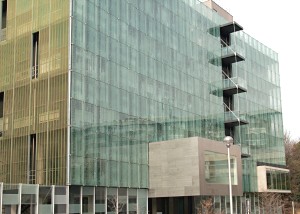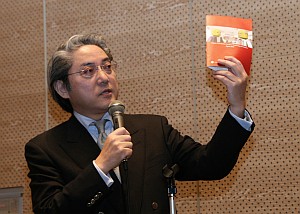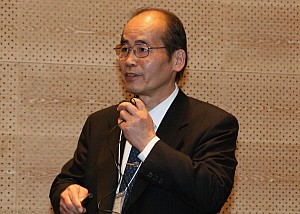Features
Features
Biophysics at Nagoya University: The first half century
- ツイート
- 2010/04/29
29 April 2010
A symposium celebrating 50 years of biophysics research at Nagoya University was held on 12-14 March 2010 at the Noyori Materials Science Laboratory and the Noyori Conference Hall, Nagoya University, drawing more than 150 participates from Japan and overseas.
 It is no exaggeration to say that Nagoya University is the birthplace of Japanese biophysics research. It was here in 1954 that Fumio Oosawa, then an associate professor in physics specializing in colloids and polymer electrolytes at the Nagoya University Faculty of Science, began his pioneering research into the physical properties of actin, a key protein in muscle contraction. His subsequent collaboration with Fujio Egami, a chemist at Nagoya University, and biologist Tsuneo Yamada led to the creation of the Japanese Biophysical Society in 1960 and the opening in Nagoya of Japan's first molecular biology institute the following year. The early years of biophysics research at Nagoya University were witness to a raft of pioneering discoveries made by life scientists such as Reiji Okazaki, Goro Eguchi, Kinichiro Miura and Shosuke Takemura, achieving them international stature. The molecular biology institute was reformed as a university department in 1987 and in recent years has been supplemented by the Structural Biology Research Center.
It is no exaggeration to say that Nagoya University is the birthplace of Japanese biophysics research. It was here in 1954 that Fumio Oosawa, then an associate professor in physics specializing in colloids and polymer electrolytes at the Nagoya University Faculty of Science, began his pioneering research into the physical properties of actin, a key protein in muscle contraction. His subsequent collaboration with Fujio Egami, a chemist at Nagoya University, and biologist Tsuneo Yamada led to the creation of the Japanese Biophysical Society in 1960 and the opening in Nagoya of Japan's first molecular biology institute the following year. The early years of biophysics research at Nagoya University were witness to a raft of pioneering discoveries made by life scientists such as Reiji Okazaki, Goro Eguchi, Kinichiro Miura and Shosuke Takemura, achieving them international stature. The molecular biology institute was reformed as a university department in 1987 and in recent years has been supplemented by the Structural Biology Research Center.
The occasion of the 50th anniversary of biophysics as a formal discipline at Nagoya University was celebrated by an international symposium held on 12-14 March 2010 that drew more than 150 participants from Japan and around the world, including invited lectures by researchers from Singapore, the Netherlands and the USA. Originally the brainchild of Nagoya University vice president and biological chemist, Yoshihito Watanabe, the event was co-chaired by Nagoya University biophysicist Shigeki Mitaku and sponsored by the Biophysics and Structural Biology Group at Nagoya University, the Structural Biology Research Center and the Center for Computational Science.

In their opening remarks on the first day of the symposium, Mitaku and Nagoya University presidential advisor Yoshinobu Baba both referred to the prestigious history of biophysics at Nagoya University, and in particular to the work of Fumio Oosawa, whose outstanding contributions to research and teaching were recognized by, among many other awards, bestowment of the 2009 Nature Award for Creative Mentoring in Science. The audience at the symposium was treated to a pot pourri of lectures from other distinguished Nagoya University alumni who combined reminiscences of their early experiences in biophysics research at Nagoya University with presentations on topics as diverse as information flow from genes to proteins, the role of water in biological functions, the evolution and mechanism of photosynthesis, and real-world modeling of the dynamical aspects of living systems. Each presentation was followed by a lively question and answer session that spilled over into the pre-dinner evening mixer event.
If the lectures on the first day of the symposium were of an eclectic nature, the program on the remaining two days was more tightly focused, consisting of 25 lectures organized into four areas: motor systems, biosystems, new methods and membranes. These were augmented by a poster session held in the Noyori Conference Hall on the afternoon of the Saturday session, which drew contributions from 30 presenters divided into similar topic groups.
A notable feature of the program was the proportion of presentations given on computational and theoretical topics, which was higher than might have been expected for a seminar in biophysics. But this is part of a deliberate strategy by Nagoya University to stimulate cross-disciplinary research in the field, as Mitaku told Nagoya University Research: "The balance between experimental and theoretical and computational scientists is a particular feature of our work here. After all, professor Oosawa himself was both a theoretician and an experimentalist," he explains. Looking forward, Mitaku foresees these interrelationships growing in importance. "Until recently, research in the life sciences has been rather skewed towards the experimental side of things, but in the future, the use of computer-based techniques such as bioinformatics will become increasingly important. In this respect, I'd like to think that this seminar will come to be seen as something of a forerunner in the field."
 Mitaku further noted the importance of pursuing a cross-disciplinary strategy for dealing with general questions in the fields of biophysics and the life sciences. "Biophysics embraces a wide range of scales, from the atomic level through the microscale and even up to macro-scale systems such as the genome. There are many approaches for tackling these questions, and the dual use of theoretical and experimental techniques will be extremely important. Here again I think Nagoya University can take a lead."
Mitaku further noted the importance of pursuing a cross-disciplinary strategy for dealing with general questions in the fields of biophysics and the life sciences. "Biophysics embraces a wide range of scales, from the atomic level through the microscale and even up to macro-scale systems such as the genome. There are many approaches for tackling these questions, and the dual use of theoretical and experimental techniques will be extremely important. Here again I think Nagoya University can take a lead."
When asked to speculate on what the future has in store for biophysics research at Nagoya University, Mitaku was sanguine: "It's hard to look 50 years down the road but I am sure that in the next 20 or 30 years we will see a number of step changes in biophysics and life sciences research. What exactly these will be is difficult to say, but I am sure that the sort of strong partnership between the experimental and theoretical branches of the subject will be vital in realizing the necessary breakthroughs." The evidence from this seminar is that Nagoya University is well-placed to play a leading role in shaping biophysics research in the next half century.
NU Research
(English)

